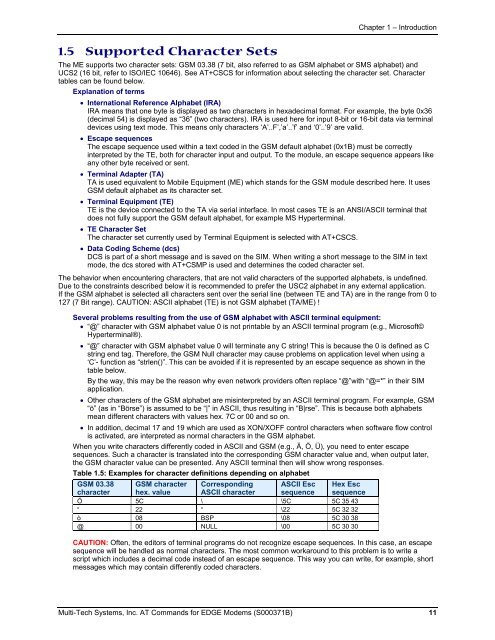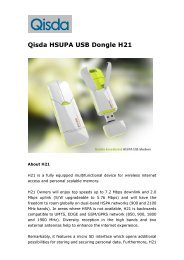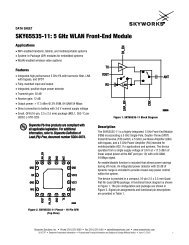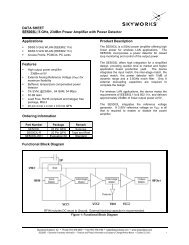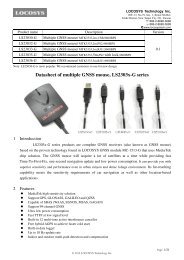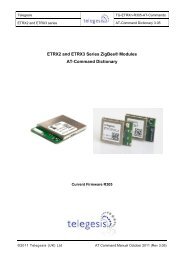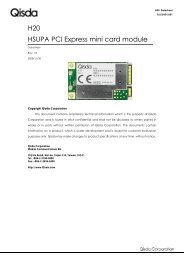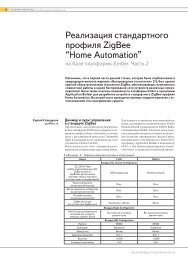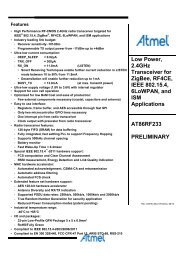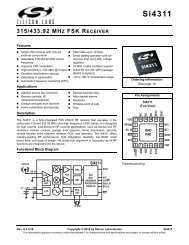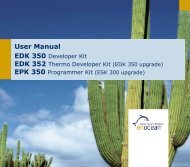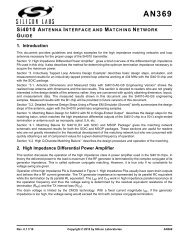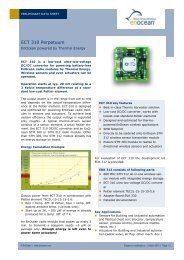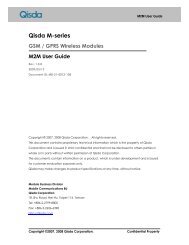AT Command Reference Guide for EDGE Wireless ... - wless.ru
AT Command Reference Guide for EDGE Wireless ... - wless.ru
AT Command Reference Guide for EDGE Wireless ... - wless.ru
You also want an ePaper? Increase the reach of your titles
YUMPU automatically turns print PDFs into web optimized ePapers that Google loves.
1.5 Supported Character Sets<br />
Chapter 1 – Introduction<br />
The ME supports two character sets: GSM 03.38 (7 bit, also referred to as GSM alphabet or SMS alphabet) and<br />
UCS2 (16 bit, refer to ISO/IEC 10646). See <strong>AT</strong>+CSCS <strong>for</strong> in<strong>for</strong>mation about selecting the character set. Character<br />
tables can be found below.<br />
Explanation of terms<br />
• International <strong>Reference</strong> Alphabet (IRA)<br />
IRA means that one byte is displayed as two characters in hexadecimal <strong>for</strong>mat. For example, the byte 0x36<br />
(decimal 54) is displayed as “36” (two characters). IRA is used here <strong>for</strong> input 8-bit or 16-bit data via terminal<br />
devices using text mode. This means only characters ‘A’..F’,’a’..’f’ and ‘0’..’9’ are valid.<br />
• Escape sequences<br />
The escape sequence used within a text coded in the GSM default alphabet (0x1B) must be correctly<br />
interpreted by the TE, both <strong>for</strong> character input and output. To the module, an escape sequence appears like<br />
any other byte received or sent.<br />
• Terminal Adapter (TA)<br />
TA is used equivalent to Mobile Equipment (ME) which stands <strong>for</strong> the GSM module described here. It uses<br />
GSM default alphabet as its character set.<br />
• Terminal Equipment (TE)<br />
TE is the device connected to the TA via serial interface. In most cases TE is an ANSI/ASCII terminal that<br />
does not fully support the GSM default alphabet, <strong>for</strong> example MS Hyperterminal.<br />
• TE Character Set<br />
The character set currently used by Terminal Equipment is selected with <strong>AT</strong>+CSCS.<br />
• Data Coding Scheme (dcs)<br />
DCS is part of a short message and is saved on the SIM. When writing a short message to the SIM in text<br />
mode, the dcs stored with <strong>AT</strong>+CSMP is used and determines the coded character set.<br />
The behavior when encountering characters, that are not valid characters of the supported alphabets, is undefined.<br />
Due to the constraints described below it is recommended to prefer the USC2 alphabet in any external application.<br />
If the GSM alphabet is selected all characters sent over the serial line (between TE and TA) are in the range from 0 to<br />
127 (7 Bit range). CAUTION: ASCII alphabet (TE) is not GSM alphabet (TA/ME) !<br />
Several problems resulting from the use of GSM alphabet with ASCII terminal equipment:<br />
• “@” character with GSM alphabet value 0 is not printable by an ASCII terminal program (e.g., Microsoft©<br />
Hyperterminal®).<br />
• “@” character with GSM alphabet value 0 will terminate any C string! This is because the 0 is defined as C<br />
string end tag. There<strong>for</strong>e, the GSM Null character may cause problems on application level when using a<br />
‘C’- function as “strlen()”. This can be avoided if it is represented by an escape sequence as shown in the<br />
table below.<br />
By the way, this may be the reason why even network providers often replace “@”with “@=*” in their SIM<br />
application.<br />
• Other characters of the GSM alphabet are misinterpreted by an ASCII terminal program. For example, GSM<br />
“ö” (as in “Börse”) is assumed to be “|” in ASCII, thus resulting in “B|rse”. This is because both alphabets<br />
mean different characters with values hex. 7C or 00 and so on.<br />
• In addition, decimal 17 and 19 which are used as XON/XOFF control characters when software flow control<br />
is activated, are interpreted as normal characters in the GSM alphabet.<br />
When you write characters differently coded in ASCII and GSM (e.g., Ä, Ö, Ü), you need to enter escape<br />
sequences. Such a character is translated into the corresponding GSM character value and, when output later,<br />
the GSM character value can be presented. Any ASCII terminal then will show wrong responses.<br />
Table 1.5: Examples <strong>for</strong> character definitions depending on alphabet<br />
GSM 03.38 GSM character Corresponding ASCII Esc Hex Esc<br />
character hex. value ASCII character sequence sequence<br />
Ö 5C \ \5C 5C 35 43<br />
“ 22 “ \22 5C 32 32<br />
ò 08 BSP \08 5C 30 38<br />
@ 00 NULL \00 5C 30 30<br />
CAUTION: Often, the editors of terminal programs do not recognize escape sequences. In this case, an escape<br />
sequence will be handled as normal characters. The most common workaround to this problem is to write a<br />
script which includes a decimal code instead of an escape sequence. This way you can write, <strong>for</strong> example, short<br />
messages which may contain differently coded characters.<br />
Multi-Tech Systems, Inc. <strong>AT</strong> <strong>Command</strong>s <strong>for</strong> <strong>EDGE</strong> Modems (S000371B) 11


